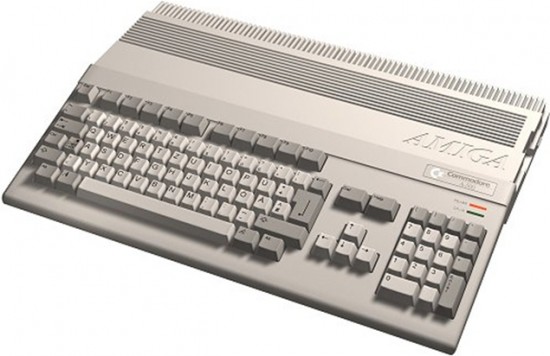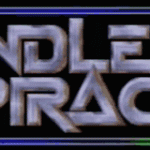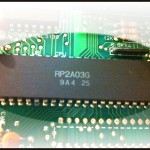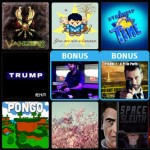 Music has many forms, and music production has probably at least as many forms as well.
Music has many forms, and music production has probably at least as many forms as well.
I first started writing music on a computer in 1987, and nearly 30 years later I realized how important simple, fundamental things really are. My youngest son is five, and was taken by a 25 key synthesizer I recently acquired (the Korg Triton Taktile 25). He wanted one too, and I told him “you can have one, but you need to learn at least a little music first. This is no toy.” And with those words I realized the same words were just as true for me.
So with that in mind, with this bit of writing I’m going to talk about MODs, and the Demo Scene.
I’m not sure exactly where the “Scene” started. That’s what we called it anyway. It sounded cool, and to some degree it was cool. We were kids making very cool sounding and looking things on computers. Motion art, special effects, and of course music. But if I had to guess, I’m fairly sure the Scene began in Europe and Scandinavia in the late 1980s, with computers such as the Commodore 64 and much more so, the Commodore Amiga.
From the time personal computers became possible to buy, they were many things to all who brought them home. To a father it might be a way to work from home a bit, balance the checkbook, or write a few letters. The same for a mother. But for the kids, these machines were pure magic. They made art. They had games. And they made sounds. So from the early days of the Bulletin Board Systems, those modem accessible collections of shared software and communication of groups of like minded folk, people would make art and entertainment of all kinds. Other than games, there were demos.
Simply put, a demo is like a music video. It can contain artwork, both still and animated, but perhaps most interestingly, demos were and still are a way for people to squeeze every last bit of capability out of a computer. People could make Wolfenstein 3D fit into 64k. They could make Herbie Hancock’s song “Rockit” sound nearly like the studio recorded track itself. People reveled in creation of these demos, and groups became like rock bands.
One such group, Future Crew, hailed from Finland. This team consisted of programmers, artists and musicians, but each one was a rock star in his own right. In fact, the team would go on to form Remedy Entertainment and create the Max Payne series. Beforehand they made demos that became legend, perhaps the most well known of which is Second Reality. Check it out, it still holds up today. And why? Because Future Crew built this demo without a budget and without resources except their own home PCs.
Musicians came out of these groups. They worked with a format called MODs, which is simply playing individual samples to create music using step time composition. MODs turned previous synth tone compositions on systems such as C64 into full blown dance tracks. They really sounded pro, which was a huge milestone for computer music. The Zorro 4 channel chipset of the Amiga enabled a great deal of power with MODs. And each member of a group had a “handle”, their nicknames that they would be called at Scene parties throughout Scandinavia and Europe. Future crew had Purple Motion (Jonne Valtonen) and Skaven (Peter Hajba, who I would later work with on Bejeweled 3). The group Orange had Dune (Lassi Nikko). And before these musicians came marvels of 4 channel writing such as Lizardking (Gustaf Greberg) and Captain (Markus Kaarlonen). When these tunes were played with the preface “yeah, I made this on my home computer”, jaws would drop. From 4 channel creations on MED and ProTracker came 16 channel massive compositions full of depth.
The groups would join together and compete at parties, which would gather thousands of sceners together to showcase their works, participate in a rave, or make demos in the span of 24-48 hours. Perhaps the largest of these in the 90s was Assembly. Based in Helsinki, Assembly would attract sponsors such as Microsoft and IBM. Reps from these companies would make job offers on the spot to prospective code wranglers. Other parties such as NAID (North American International Demo competition) would be held in Canada.
Before continuing I should point out that writing MODs made traditionally trained musicians and composers rather taken aback. MODs couldn’t reproduce by a long shot the detail and texture of a live performance, but compared to MIDI writing at the time, it held its own ably, because manipulating samples directly yielded a power that predefined instrumentation couldn’t match. While this was impressive, it nonetheless demonstrates that great things come out of setting limits. MODs with 4 channels are extremely limiting, yet songs that rivaled dance tracks on the Billboard charts were made with those limitations. Now that we’ve established that important realization, on with the progression of MOD music.
Not only did my own jaw drop when I heard these creations, but I had to make some of my own. I quickly found a fellow composer on a BBS in my own state of Maryland and played him some early works. His handle was Sirrus (Bryan Rudge) and he ran a music group: Bass Productions. Bass was a group of mostly local composers whose works were distributed via a BBS Bryan ran from his parents’ house.
Part of what fueled creativity was feedback. #trax was / is an IRC channel that composers would distribute their latest tracks and get either smacked down with constructive (and not so constructive) criticism, or hailed and reshared throughout the fledgeling internet. Along with Purple Motion and Skaven some new great artists rose up, such as Andrew Sega (Necros), Basehead (Dan Gardopee), and in Europe the greats included WAVE. Some massive music groups formed, the largest of which was KFMF. Kosmic Free Music Foundation had almost all MOD writers in its ranks at one point or another, and was run by Dan Nicholson aka. Maelcum. KFMF also made some demos, one of which made 2nd place at NAID.
About this time (late 90s), skill with MOD files could lead many places, and games were certainly one of them. Previously nearly all Amiga projects used MODs from Shadow of the Beast and the whole lineup from Psygnosis to Battle Squadron by Ron Klaren. Greats like Rob Hubbard who would later head up the Electronic Arts audio department wrote music for titles like “Populous” and “Budokan”. Future Crew used MODs in “Death Rally”, their first game. And some companies adopted MODs above the alternative, General MIDI, to some success. One of them was Epic Megagames (now known as Epic Games). Epic’s first MOD games were Epic Pinball and Jazz Jackrabbit, written by Robert Allen. After these games came more ambitious projects such as “Unreal” and “Unreal Tournament”, that I was lucky enough to write with some fantastic folks like Michiel Van Den Bos, Andrew Sega, Dan Gardopee and Peter Hajba.
After these projects came Deus Ex, the last major MOD project for me, and by 2000 MODs were being replaced by live orchestra, full studio tracks and licensed music, the start of modern game music and a very different time.

While my MOD days are behind me, remember that “limit” realization I wrote about earlier? It applies far more now than ever. With a few hundred dollars and a computer just about anyone can write tracks that easily outclass any MOD. The difference is that, despite the surprise that traditional composers would express at MOD writing, MODs were easy to write. But GOOD sounding MODs were and are hard as fuck to make sound decent. The same applies to ANY tool, from pencil and notation paper to a live orchestra with all the hardware and plugins in the world.
Disclaimer: This article is an independent & unsoliciated guest piece by Alexander Brandon, who is the composer for several video games including some OSV has covered in the past.











































Zorro is name of the Amiga data bus, Paula is the 4 channel sound chip.
What a great embodiment of a time when game music was undergoing such a dramatic transition. It’s great to get your perspective from the trenches! As someone who passivly enjoyed an early part of the scene through the 4″ screen of my executive C64 I can say that the whole thing *did* feel like a revolution. (what did our parents think we were doing with those “personal computers” anyway?” I played all of the games, but I have the most vivid memories of intro screens from “importers”; Load “*”,8,1 unleashing technicolour rasterbars and SID chip mayhem. You did a great job of describing the bridge between synth->MIDI->MOD and it would be great to hear a similar story from where you left off with MOD and the eventuality of Red Book Audio. Thanks for tunring back the wheels of time!
Awesome read!
Already met Purple Motion, Skaven and Necros several times Great guys!
Great guys!